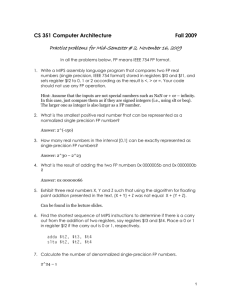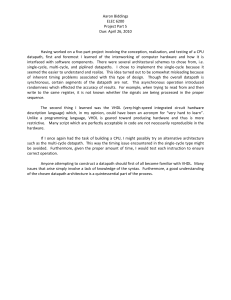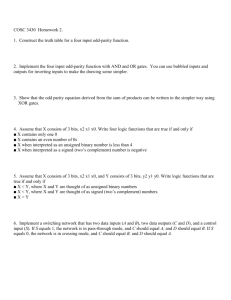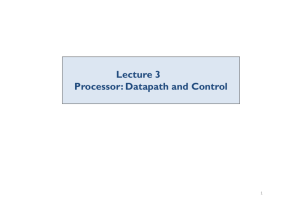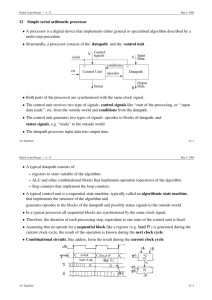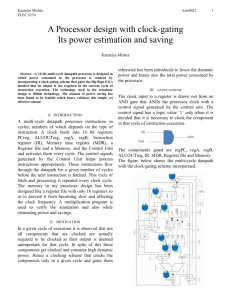The Processor and its Datapath
advertisement
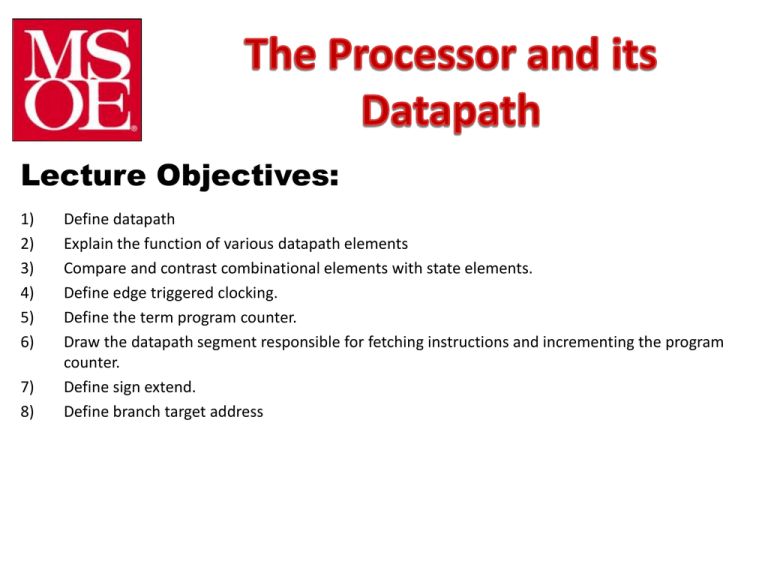
Lecture Objectives: 1) 2) 3) 4) 5) 6) 7) 8) Define datapath Explain the function of various datapath elements Compare and contrast combinational elements with state elements. Define edge triggered clocking. Define the term program counter. Draw the datapath segment responsible for fetching instructions and incrementing the program counter. Define sign extend. Define branch target address Datapath - A collection of datapath elements within a CPU that perform various data processing operations • Datapath Element – A functional unit used to operate on or hold data within a processor – Elements that operate on data are all combinational elements – Elements that hold data are state elements CS2710 Computer Organization 2 Combinational Elements • The output of a combinational element depends only on the current input(s) – No “memory” of past inputs • Given the same input, a combinational element always produces the same output • In MIPS, nearly all inputs and outputs are 32 bits wide X 32 32 Y X+Y 32 CS2710 Computer Organization 3 State Elements • Output(s) depends on both input(s) and current state • Contain internal storage – Internal state may be lost on power loss – Internal state can be saved and restored 0x00400a0 0x3c011001 (differs based on what is in instruction memory) CS2710 Computer Organization 4 A clocking methodology defines when signals (inputs and outputs) can be read and written • Edge Triggered Clocking – A clocking scheme in which all state changes occur on a clock edge – One of the clock edges (rising or falling) is chosen to be the active clock edge (by the designers) – States are stable at the active clock edge, and in transition between • The Clock cycle time is determined by the slowest datapath operation – Since every datapath element takes some finite amount of time to function Read Write Rising clock edge Clock cycle CS2710 Computer Organization 5 Multiple clock cycles are needed for operations involving multiple state elements Read Write Clock cycle Read Write Clock cycle CS2710 Computer Organization 6 More datapath elements • Program counter (PC) – A special-purpose register containing the address of the instruction in the program being executed 0x00400a0 0x00400a0 Write Read • Sign extender – Increases the size of a data item (e.g. from 16 to 32 bits) by replicating the high order sign bit of the original data 0xf3a0 item to the high order bits of the Write larger destination data item 0x74b2 CS2710 Computer Organization 0xfffff3a0 Read 0x000074b2 7 ALU: Arithmetic/Logic Unit • • • • • Arithmetic Logical comparison Load from memory to register Store from register to memory Branching CS2710 Computer Organization 8 First step in executing an instruction: Instruction Fetch Determines the next instruction to execute; takes 1 cycle 0x004000a4 (next instruction address) Note: The signal going back to the PC is greatly simplified here. The actual signal is more complex. Start of clock cycle End of clock cycle 0x004000a0 0x3c011001 0xc421002c (next instruction Code) CS2710 Computer Organization 9 Step 2: Instruction Decode and Register Fetch • Consider add $t1, $s1, $s2 whose instruction code is 0x2824820 – – – – 0 17 18 8 0 32 6 bits 5 bits 5 bits 5 bits 5 bits 6 bits Extract register numbers (17,18,8) Extract part of op and funct (0, 32) and recombine as 4-bit ALU Opcode Present to ALU (not shown) Takes 1 cycle ALU Opcode for add 17 18 Value in $17 8 32-bit result to be placed in $8 will arrive here in 2 more cycles Value in $18 Step 3: Execute • Perform operation (in this example, add $t1, $s1, $s2) – The ALU adds the values in $17 and $18 presented to it from the Instruction Decode/Register Fetch of Step 2 – Takes 1 cycle ALU Opcode for add 17 18 Value in $17 8 32-bit result to be placed in $8 will arrive here in a subsequent cycle Value in $18 32-bit result to be placed in $8 in a subsequent cycle Step 4: Memory access • In add $t1, $s1, $s2, memory is not accessed. • Instead: consider sw $t1, ($s1), where the data at the memory address contained in $s1 needs to be stored (or fetched, as in the case of lw) – The ALU sends the data in $t1 to the address stored in $s1, which takes 1 cycle • For lw, the ALU fetches the data from memory into a cache – Although add does not access memory, 1 cycle is still consumed (idle) – ALL instructions consume 1 cycle for step 4, whether they access memory or not! • This is done uniformly for all instructions for uniformity so that every instruction takes 5 steps ALU Opcode for sw 17 Address in $17 8 Addr in $17 Not used Value in $8 Step 5: Register writeback • Back to add $t1, $s1, $s2 – The result from the add is written back to $8 ($t1) in step 5 – For an sw instruction, nothing happens in this cycle • For an lw instrcution, the value is transferred from the cache to $8 – Consumes 1 cycle in all cases ALU Opcode 17 18 Value in $17 8 32-bit result of add Value in $18 A complete instruction in MIPS requires 5 steps/cycles. This is true for all instructions, whether the instruction needs to do something in each step or not! CS2710 Computer Organization 14 Example times for various datapath element functions (step times) Step 1 Step 2 Step 3 Step 4 Step 5 Instruction Fetch Register Read ALU Operation Data Access Register Write 200ps 100ps 200ps 200ps 100ps •If executed sequentially, requires a total time of 800ps •…and, the step times are non-uniform! CS2710 Computer Organization 15
